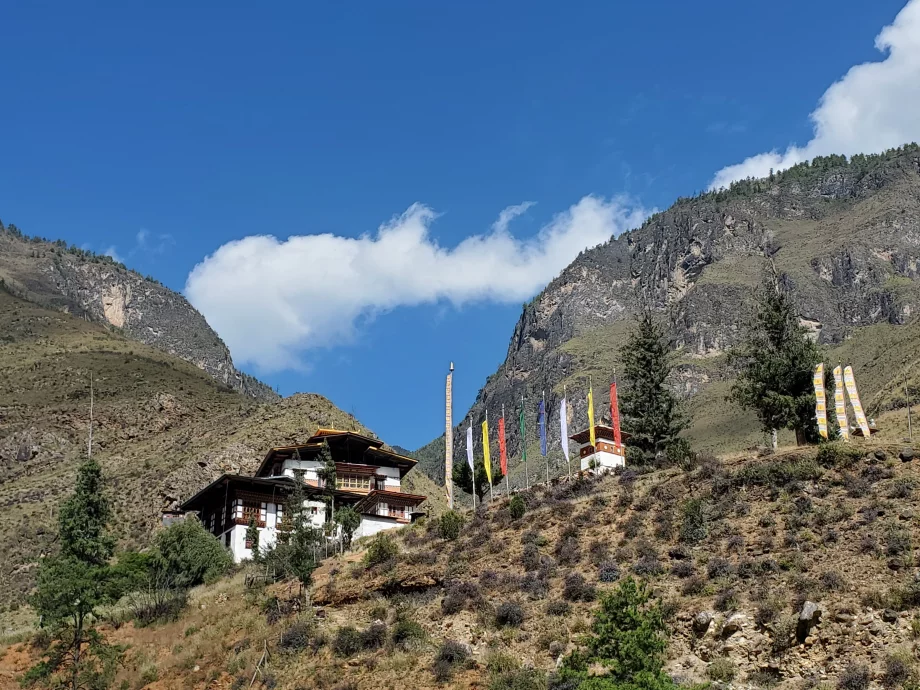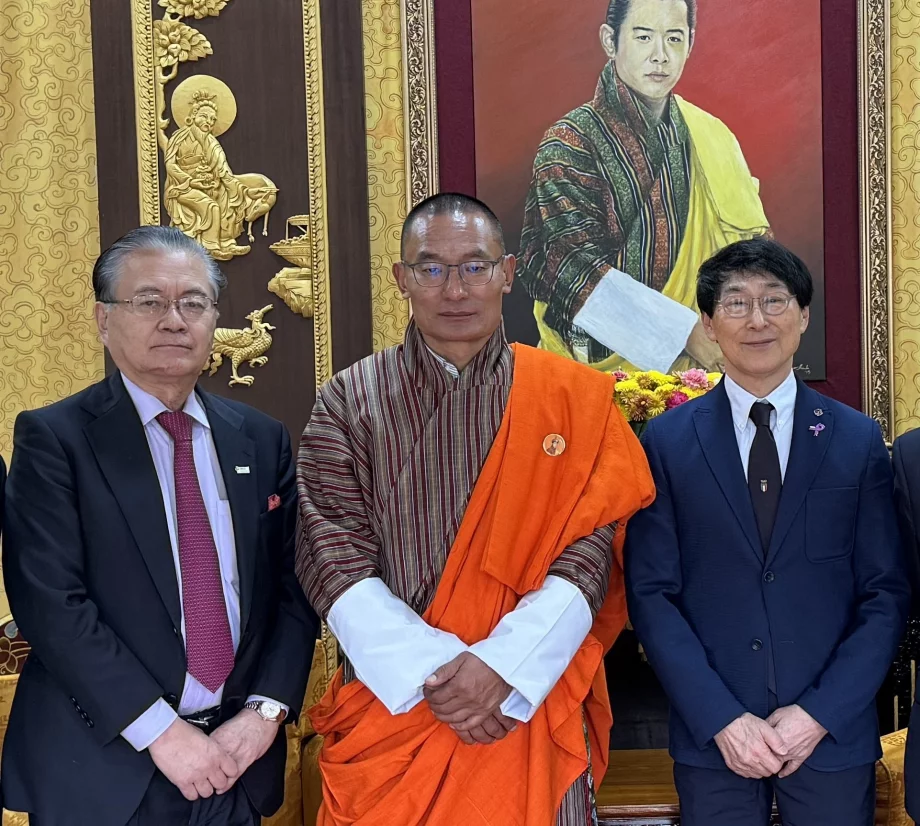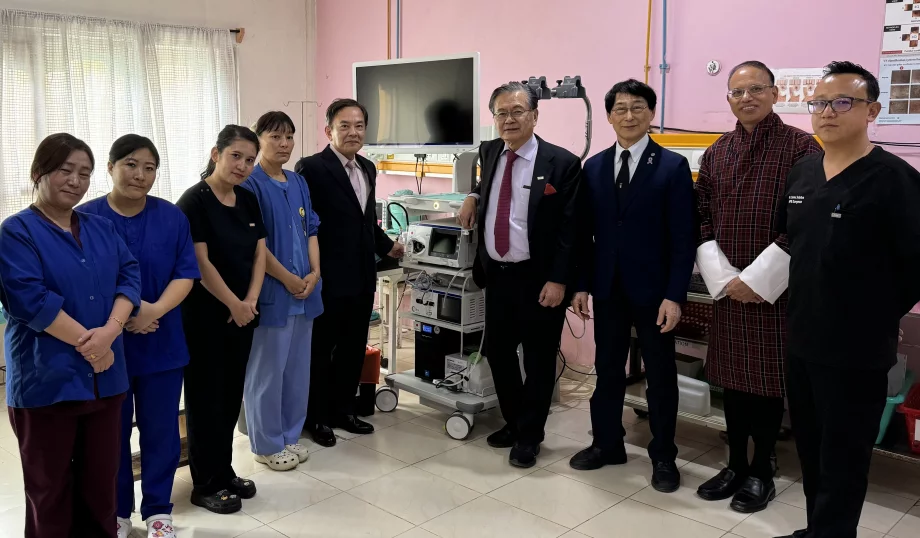
Prof.Hisao Tajiri writes: Prof. Seigo Kitano, President of the Asian-Pacific Society for Digestive Endoscopy (A-PSDE), Prof. Yoshio Yamaoka, head of Science and Technology Research Partnership for Sustainable Development (SATREPS), and I visited Bhutan. I participated in my capacity as A-PSDE Vice President.
Bhutan is a small country in the Himalayas with a population of around 800 000. Despite its size, Bhutan has adopted Gross National Happiness (GNH) as its guiding national policy, making the maximization of GNH the core principle of national development. GNH is not measured only by economic growth but emphasizes a balance between the mental and spiritual wellbeing of its citizens, valuing social, cultural, and environmental harmony. This philosophy is rooted in Buddhist thought, and GNH by four key pillars: (1) sustainable and equitable socioeconomic development, (2) environmental conservation, (3) preservation and promotion of culture, and (4) good governance.
The journey from Bhutan's only international airport in Paro to the capital, Thimphu, takes approximately one hour by car along a rugged, mountainous road at an altitude of 2500 meters. The climb to temples at higher ground can reach nearly 3000 meters, can cause mild altitude sickness. In fact, during a visit to the capital’s main hospital, I experienced a rapid heartbeat and shortness of breath from repeatedly climbing the stairs to the fourth floor, as there are no elevators in the hospital.

Bhutan has eight facilities where endoscopy is available. While there was no medical university until recently, one was finally established last year, and the inaugural class of first-year students have begun their studies.
On October 24, we held a ceremony to mark the donation of an endoscopy equipment set, with the Health Minister in attendance. To date, three state-of-the-art endoscopy sets have been donated through the SATREPS project by the Japan Agency for Medical Research and Development (AMED) and the Japan International Cooperation Agency (JICA). On the morning of October 25, we met with former Prime Minister Lotay (an endoscopy physician himself). Throughout his early career, he traveled to mountain villages across Bhutan performing endoscopies, and he remains a highly popular doctor nationwide. Later that same day, we met with Prime Minister Tshering to discuss potential future healthcare support and cooperation.
The number of physicians nationwide is 376, a very low provision in global terms, accounting for 50 per 100 000 people. Currently, most Bhutanese doctors have trained abroad, studying, and completing their residencies in nearby countries such as India, Bangladesh, and Sri Lanka, etc. before returning to Bhutan. Healthcare and education are free for all Bhutanese citizens. There is no medical insurance system.

We visited the National Royal Hospital in Thimphu, Bhutan's largest hospital with 350 beds, which has two endoscopy rooms – one dedicated to ERCP and the other for upper and lower endoscopies. Scope cleaning is done manually as there is no automated cleaning machine. This hospital employs only one gastroenterologist, with several surgeons handling endoscopy duties. ERCP is performed every Tuesday, with five to six cases per session, primarily for bile duct stone treatment. Bhutan faces challenges in establishing a basic infrastructure for diagnostic and therapeutic endoscopy before even considering AI integration into healthcare; without continued international support there is a risk of even further widening of the current disparities between Bhutan and developed countries.
In Bhutan, there were only a few endoscopy specialists until the 2010s; however, through the JICA project, around 20 specialists have been trained in recent years. The average life expectancy is about 72 years for males and 74 for females. In terms of morbidity, infectious diseases still account for about 36%, although the trend is declining. The issue of countermeasures against tuberculosis, human immunodeficiency virus (HIV) infection, and other infectious diseases has become a challenge. The leading cause of death in the past 10 years has been alcoholic liver disease. The highest mortality rate among malignant diseases is gastric cancer, and the infection rate of Helicobacter pylori (H. pylori) is extremely high, ranging from 72.2% to 73.4%, and even to 80% in young patients under 29 years. The majority of H. pylori strains are East Asian carrying cytotoxin-associated gene A (CagA), with the more virulent strain accounting for half of cases.
In the SATREPS project, Japanese endoscopists since April 2023 have been staying at a flagship hospital in Bhutan on a two-month rotation to provide on-site endoscopic guidance. As a result, Bhutanese doctors have already detected and diagnosed 12 cases of early gastric cancer. In addition, ESD is also being performed.
Bhutan places great emphasis on human resource development. It is crucial to prioritize efforts that foster the growth of Bhutanese professionals alongside infrastructure and equipment improvements. Bhutan's dispersed, small population makes it costly to expand administrative and healthcare services in rural areas. Additionally, as a landlocked country, integrating into global supply chains and accessing overseas markets remain challenging. To overcome these obstacles, the Bhutanese government is focusing on implementing digital technologies, with Japanese government support aimed at strengthening these initiatives.
Bhutan’s endoscopic healthcare faces various challenges, including training of medical personnel, infrastructure development for medical equipment and reporting systems, and addressing healthcare needs in remote mountainous areas. This on-site observation impressed on me, in particular, the need for long-term support, and in the future we hope to collaborate with A-PSDE and seek support from WEO.
